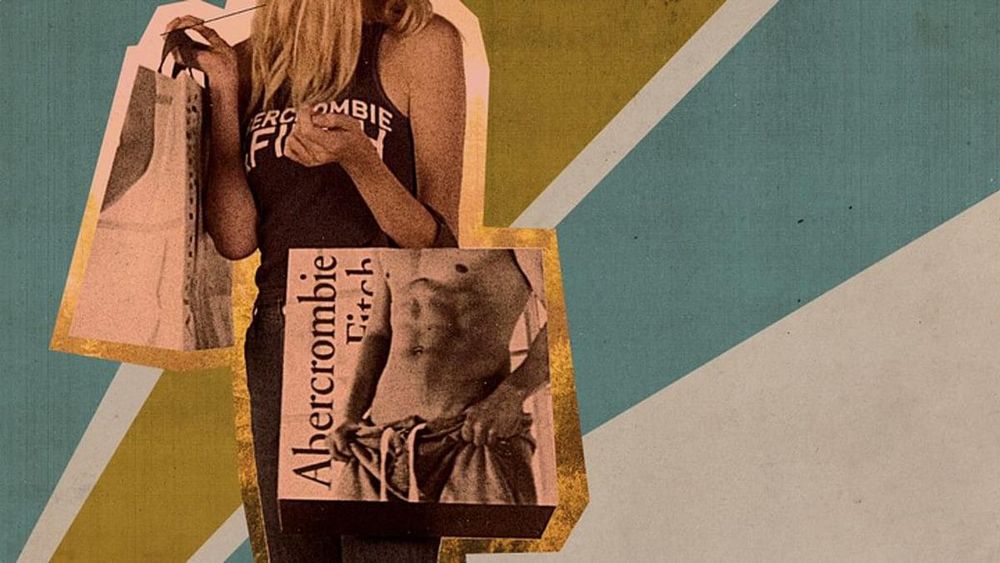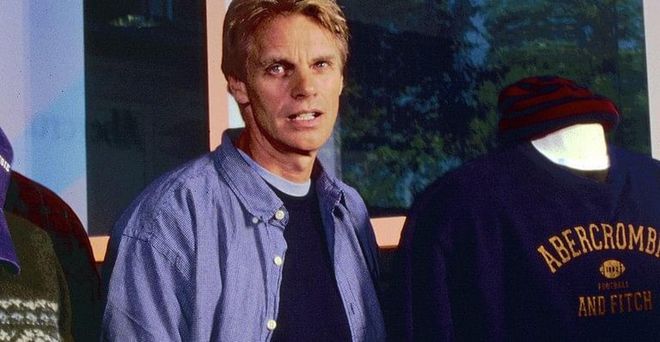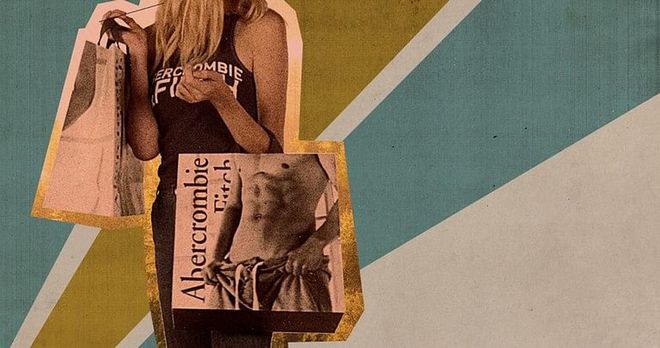Netflix's 'White Hot' Explores Mike Jeffries' Complicated History With Abercrombie & Fitch
Everyone's favorite early '00s store is in the spotlight for all the wrong reasons in Netflix's latest doc.

From its unmistakable branding, which routinely featured scantily-clad chiselled models, to its experience-led stores, the late '90s and early '00s were in many ways defined by Abercrombie and Fitch. However, in new Netflix documentary White Hot: The Rise and Fall of Abercrombie and Fitch, viewers get a glimpse of what was really going on behind the slick veneer of the store's shutters.
And for over two decades, the person at the reins of the clothing giant was former CEO Mike Jeffries. Here's the true story behind Netflix's latest doc.
ABERCROMBIE AND FITCH'S HISTORY MIGHT SURPRISE YOU
Mike Jeffries took on the role of CEO of Abercrombie and Fitch in 1992, via Bloomberg. At the time, the brand had already been around for a century, starting life as a sporting goods store in 1892. In its previous iteration, Abercrombie was less about topless models with steel abs, and more about making hunting and fishing wear with a classic American twist. In fact, before it became a teen hotspot, Abercrombie and Fitch had dressed icons like John F. Kennedy, Amelia Earhart, and President Theodore Roosevelt.
Despite its storied past, the company struggled to maintain its fanbase, and filed for bankruptcy in 1976, via The Business of Business. After one unsuccessful relaunch, Abercrombie was acquired in 1988 by The Limited's Les Wexner for $47 million. Wexner, of course, is famous for buying Victoria's Secret in 1982 for just $1 million and turning it into an extremely profitable entity, via Forbes. His Abercrombie purchase turned into a similar success story.
By the early '00s, Abercrombie's sister brand Hollister was picking up speed, and both labels were quickly taken international. As The Fashion Law reported, at its peak, "Abercrombie boasted a network of 700 dimly-lit and thoroughly fragranced stores, 22,000 strikingly attractive employees and nearly $2 billion in annual sales." Basically, there's a good chance that at some point you ventured into the brand's low-lit paradise or ogled its oiled-up, shirtless greeters from a safe distance.
WHY IS THERE CONTROVERSY SURROUNDING EX-CEO MIKE JEFFRIES?
When Jeffries was handed the role, he was 48-years-old, and moved over from women's brand Paul Harris, via The Fashion Law. Little is known about Jeffries' private life. The CEO was previously married to Susan Hansen, with whom he shares a son.
Related article: A New Documentary On Jennifer Lopez Is Coming To Netflix

Photo: Netflix
'White Hot' Mike Jeffries Abercrombie & Fitch
Throughout his time at the fashion giant, Jeffries reportedly attempted to cultivate a youthful image of his own. As Bloomberg reported in 2014, "Jeffries, who is 70, tried to keep up appearances. He lifted weights, barefoot, in the company gym most mornings. He dyed his hair blond and regularly visited his plastic surgeon." And his uniform of choice? "[T]orn Abercrombie jeans and flip-flops," of course.
As well as cultivating a particular look, Jeffries quickly became known for his often exclusionary commentary about the Abercrombie and Fitch customer. A 2006 Salon interview was especially damning following the company's recent settlement as Jeffries said, "That's why we hire good-looking people in our stores. Because good-looking people attract other good-looking people, and we want to market to cool, good-looking people. We don't market to anyone other than that."
As if his statement about "good-looking people" wasn't clear enough, Jeffries also told Salon, "In every school there are the cool and popular kids, and then there are the not-so-cool kids. Candidly, we go after the cool kids. We go after the attractive all-American kid with a great attitude and a lot of friends. A lot of people don’t belong [in our clothes], and they can’t belong. Are we exclusionary? Absolutely. I think that what we represent sexually is healthy. It's playful. It's not dark. It's not degrading!" added the then-CEO. "And it's not gay, and it's not straight, and it's not black, and it's not white. It's not about any labels." (He apologized for the statement following the interview in 2013).
WHAT ALLEGATIONS HAVE BEEN MADE AGAINST ABERCROMBIE AND FITCH?
Netflix's White Hot specifically details Abercrombie and Fitch's era with Jeffries at the helm. During this time, and after it, the company has faced several lawsuits and drawn criticism from multiple communities who have accused the brand of employment discrimination. Abercrombie and Fitch have regularly denied these allegations.
For instance, a 2003 class action lawsuit was filed against the brand, alleging that Abercrombie and Fitch had perpetrated "discrimination against African-American, Latino and Asian American applicants and employees." A settlement was reached in November 2004 totaling $40 million dollars, according to the New York Times, with the company required to increase diversity within its hiring practices and implement diversity and inclusion training as a result, something that's discussed at length in White Hot.
After Abercrombie settled the lawsuit, Jeffries told Salon, "I don't think we were in any sense guilty of racism, but I think we just didn't work hard enough as a company to create more balance and diversity. And we have, and I think that's made us a better company. We have minority recruiters. And if you go into our stores you see great-looking kids of all races."
Abercrombie and Fitch was hit with another major lawsuit in 2008. Per the U.S. Equal Employment Opportunity Commission, "The case involved Abercrombie's refusal to hire Samantha Elauf, a Muslim, because of her religious practice of wearing a hijab. ... She was denied hire for failing to conform to the company's 'look policy,' which Abercrombie claimed banned head coverings."
However, via the U.S. Equal Employment Opportunity Commission, "the Supreme Court held that an employer may not refuse to hire an applicant if the employer was motivated by avoiding the need to accommodate a religious practice. Such behavior violates the prohibition on religious discrimination contained in Title VII of the Civil Rights Act of 1964." In 2015, Elauf received monetary damages from Abercrombie following the Supreme Court ruling.
Related article: Netflix’s ‘Single’s Inferno’ Season 2 Is Confirmed

Photo: Netflix
'White Hot' Netflix Abercrombie & Fitch
Abercrombie and Fitch also regularly faced criticisms, many of which are explored in White Hot. For instance, the company (under new leadership) was forced to withdraw many shirts from circulation after accusations of racism in 2022, and Salon was less-than-impressed with the brand's apology. In 2005, a "girlcott" ensued regarding so-called sexist slogan's on clothing aimed at young girls. In 2011, a woman protested the company's children's brand, abercrombie, for selling padded bikinis to children.
The brand also faced extensive backlash for refusing to cater for plus-sizes at some of their retail locations, with ABC News reporting in 2013, "There was no clothing for women in sizes larger than a 10, and salespeople at the store confirmed that Abercrombie doesn't carry XL or XXL sizes for women [at specifically the New York City store]." And, per The Guardian, Abercrombie and Fitch’s strategy at one point included "refusing to create large-size clothes, limiting the biggest shirt sizes to 'large' and pants to size 10."
WHERE IS MIKE JEFFRIES NOW? AND WHAT ABOUT ABERCROMBIE?
In 2014, Jeffries stepped down from his role as Abercrombie and Fitch's CEO, according to The Guardian. Per the publication, Jeffries said in a statement, "I believe now is the right time for new leadership to take the company forward in the next phase of its development."
Related article: ‘You’ Season 4: Everything You Need To Know
Since Jeffries left the company in 2014, Abercrombie has undergone a major rebrand, with a focus of inclusivity being central to that. Discussing the documentary in an Instagram post, the official Abercrombie account stated, "While the problematic elements of that era have already been subject to wide and valid criticism over the years, we want to be clear that they are actions, behaviors and decisions that would not be permitted or tolerated at the company now."
This article originally appeared on Harper's BAZAAR US.